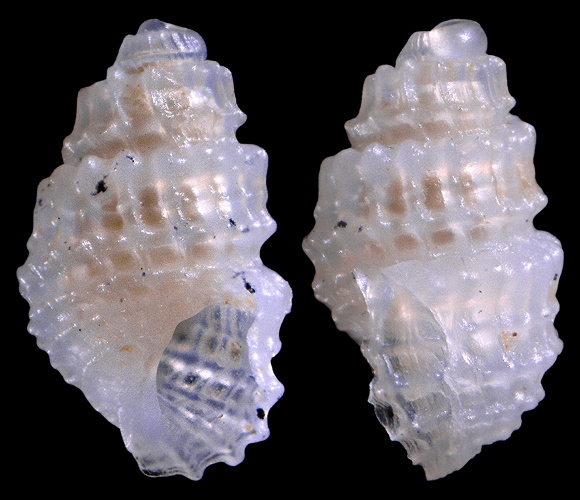
West Africa to Mediterranean. Ectoparasit of unknown molluscs in the infralittoral and deeper. The shell differs from that of excavata by its higher numbers of radial costae and of spiral ribs (3 spirals instead of 2 per average whorl, the median one being the less marked), by its rounder base and its less slender shape. – Above and below: 80-150m deep, on mud, off Málaga, Andalucia, S. Spain. 2,35mm.

Synonym intermedia Brusina, 1869, a name rejected because it was junior homonym of Odostomia intermedia Deshayes, 1861.
About his intermedia, Bruisna wrote: « This species is quite distinct and intermediate between the O. humboldti and the O. excavata. It bears two cingulations on the second whorl, three on the third and fourth ones; these cingulations are crossed by longitudinal folds of equal strength, making the whorls looking clathrate; these cingulations are missing on the adapical part of the last whorl, but subsequently reappear, six in number, on the inferior half and on the base.
The T. excavata [sic] differs from our species in that it is significantly taller and less wide, it has six whorls that are concave on half of their surface, its suture is shallower, and it bears only two transverse cingulations on each of the upper whorls. Moreover, while the O. intermedia is […] devoid of cingulations on the upper part of the last whorl, excavata has these cingulations on the last whorl as well as on the previous ones. – S. Brusina: “Gastéropodes nouveaux de l’Adriatique”, Journal de Conchyliologie vol. 17(3), Paris 1869, p.238.
About his intermedia, Bruisna wrote: « This species is quite distinct and intermediate between the O. humboldti and the O. excavata. It bears two cingulations on the second whorl, three on the third and fourth ones; these cingulations are crossed by longitudinal folds of equal strength, making the whorls looking clathrate; these cingulations are missing on the adapical part of the last whorl, but subsequently reappear, six in number, on the inferior half and on the base.
The T. excavata [sic] differs from our species in that it is significantly taller and less wide, it has six whorls that are concave on half of their surface, its suture is shallower, and it bears only two transverse cingulations on each of the upper whorls. Moreover, while the O. intermedia is […] devoid of cingulations on the upper part of the last whorl, excavata has these cingulations on the last whorl as well as on the previous ones. – S. Brusina: “Gastéropodes nouveaux de l’Adriatique”, Journal de Conchyliologie vol. 17(3), Paris 1869, p.238.
